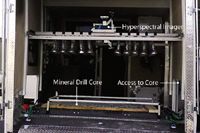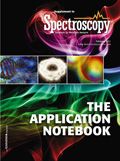Finding Gold Just Became Easier than Ever Imagined
Application Notebook
Photonic Knowledge, Inc., a spin-off of Photon etc., introduces the Core Mapper?, a hyperspectral imager that produces instantaneous, precise in situ mineralogy, lithology, and alteration mapping. This unique patented technology answers the increasing demand of the mining industry for better exploration tools.
Sébastien Blais-Ouellette1 and Christian Sasseville2, 1Photon etc. and 2Photonic Knowledge, Inc.
Photonic Knowledge, Inc., a spin-off of Photon etc., introduces the Core Mapper™ , a hyperspectral imager that produces instantaneous, precise in situ mineralogy, lithology, and alteration mapping. This unique patented technology answers the increasing demand of the mining industry for better exploration tools.
Based on Photon etc's hyperspectral imaging technology the Core Mapper™ delivers a series of monochromatic images at user-specified wavelengths between 400 and 1000 nm, offering instant in situ mineral identification. The hyperspectral imager simultaneously analyses five drill core boxes with a spatial resolution of 1 mm2 per pixel and a field of view of 1.5 m2 . Spatial resolution is 900 times better and field of view is 1666 times wider than any currently available hand-held mineral spectrometer. It can provide fast mineralogy fields mapping services, as high as 1500 drill core meters per day with one imager.
Experimental Conditions
Using the optimized Hyperspectral Imager designed specifically for mineral identification, Photonic Knowledge demonstrated the unique precision of the Core Mapper™ to a mine site in the Rouyn-Noranda region (Figure 1).

Figure 1: Transportable laboratory setup.
Two drilling holes were dug and assessed. Gold analysis performed on the core of the first hole indicated gold values averaging 5 to 7 g/ton. The second hole was only partially sampled based on the geologist's assessment and labelled "of limited interest." No supplementary gold assays were performed on the second hole.
Optical spectra provide crystal field characteristics of transition metals, lathanides, actinides, and spectro-chemical clues on ligand contents. Using the Core Mapper™, Photonic Knowledge identified proper weighting of spectral classes vectorizing the gold mineralization on the first hole. This algorithm was then applied to the second hole and the same gold vectors were identified. Assays were subsequently performed on samples from the second hole yielding 0.1 g/ton to 0.5 g/ton, averaging 0.2 g/ton on 5 meters illustrating the accuracy and detection limit of the Core Mapper™ as well as the high potential for ore vectorization (Figure 2). Although subeconomic, this finding was significant as an indicator of proximity to the main mineralization zone.

Figure 2: Example of ore vectorization.
Conclusion
Resulting in more than just an increase in efficiency, the Hyperspectral Imager supplies information on both spectral and spatial content, creating new opportunities for analysis, pushing the boundaries of the most demanding applications in mineral identification. Photonic Knowledge's optimized hyperspectral cube allows for spectral analysis of each and every pixel of a full resolution image, amounting to no more fastidious x-y scanning of the samples.
The Core Mapper™ technology affords the mining industry the opportunity to see things never seen before. The precision and speed with which it performs diagnostics of material, physical, or molecular is unparalleled. With a single acquisition, the photonic imaging system discovers gold bearing zones in a way geologists have only dreamed about!
Photon etc.
5795, Gaspé, #222, Montreal, Quebec, H2S 2X3, Canada
tel. (514) 385-9555, fax (514) 279-5493
Website: www.photonetc.com
Photonic Knowledge
481 Grande-Côte, Rosemère, Quebec, J7A 1M1, Canada
tel. (450) 965-9913, fax (450) 621-8706
Website: www.photonicknowledge.com

LIBS Illuminates the Hidden Health Risks of Indoor Welding and Soldering
April 23rd 2025A new dual-spectroscopy approach reveals real-time pollution threats in indoor workspaces. Chinese researchers have pioneered the use of laser-induced breakdown spectroscopy (LIBS) and aerosol mass spectrometry to uncover and monitor harmful heavy metal and dust emissions from soldering and welding in real-time. These complementary tools offer a fast, accurate means to evaluate air quality threats in industrial and indoor environments—where people spend most of their time.
NIR Spectroscopy Explored as Sustainable Approach to Detecting Bovine Mastitis
April 23rd 2025A new study published in Applied Food Research demonstrates that near-infrared spectroscopy (NIRS) can effectively detect subclinical bovine mastitis in milk, offering a fast, non-invasive method to guide targeted antibiotic treatment and support sustainable dairy practices.
Smarter Sensors, Cleaner Earth Using AI and IoT for Pollution Monitoring
April 22nd 2025A global research team has detailed how smart sensors, artificial intelligence (AI), machine learning, and Internet of Things (IoT) technologies are transforming the detection and management of environmental pollutants. Their comprehensive review highlights how spectroscopy and sensor networks are now key tools in real-time pollution tracking.